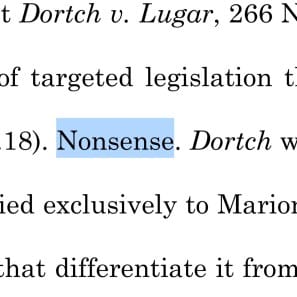Bloomington responds to State of Indiana’s appeal brief in 2017 annexation case: “Nonsense.”

On Wednesday, Bloomington filed with the Indiana Supreme Court its response to the State of Indiana’s appeal of a lower court ruling made in April, which found that a 2017 law blocking Bloomington’s annexation process was unconstitutional on two separate grounds.

Bloomington’s brief uses words like “nonsense,” “preposterous,” and “outlandish” in its response to some of the State’s arguments.
The law, enacted by the state legislature in its 2017 session, was included as part of the biennial budget bill that year. The law’s inclusion in the budget bill is one reason the Monroe County Circuit Court found it to be unconstitutional. The annexation law violated the state constitution’s “single subject” rule for legislation, according to the circuit court.
The circuit court found that the 2017 annexation law also violated the state constitution’s prohibition against “special legislation.” It’s a prohibition that doesn’t rule out legislation affecting just one municipality, which the 2017 annexation law does. Both sides agree that the 2017 law affected only Bloomington and was designed that way. The legal question is whether the special law falls within the definition of “permissible special legislation”—a kind of question on which courts have ruled in the past.
So the first briefs, which have now been filed by both sides with the Indiana Supreme Court, include dozens of citations to previous rulings on the question of what counts as permissible special legislation.
Among the previous cases to which the two sides are giving different interpretations is Dortch v. Lugar (1971), which allowed for the Unigov plan for Indianapolis and Marion County to be implemented.
In its brief, the State of Indiana says the outcome of Dortch means that the legislature can use a special law to allow the merger of city and county government—so it follows that the legislature can use a special law to prevent that kind of merger: “If, as Dortch holds, the legislature could use a local and special law to merge the municipal and county governments in Indianapolis, it could also use a local and special law to prevent the merger of Bloomington with areas of Monroe County proposed for annexation.”
Bloomington’s response to the State of Indiana’s analysis of that precedent reads in part:
…the State erroneously claims that Dortch v. Lugar…mandates, in every case, the survival of targeted legislation that “affect[s] local government structure” … Nonsense. No precedent, whether Dortch or any other case, supports the notion that special legislation is always permissible as long as it somehow involves the subject of local government organization.
A bit later, on a similar point, Bloomington’s response brief reads:
In effect, the State argues that [the constitutional prohibition against special legislation] should never apply to legislative enactments related to local government organization. This proposition is outlandish.
A conceptual point drawn out by Bloomington’s response brief is a difference between unique “characteristics” of a municipality—which could warrant targeting of special legislation—and an “activity” in which a municipality has engaged.
Among the “activities” the State of Indiana is analyzing as “characteristics” are: Bloomington’s use of remonstration waivers and the timeline it used for its annexation procedures. Those activities fell within the narrow legal constraints of Indiana’s annexation law, Bloomington says in its brief, so they cannot be analyzed as unique characteristics of Bloomington as a municipality.
From Bloomington’s response:
The only alleged traits cited by the State are not inherent characteristics at all. Rather they are activities—Bloomington’s careful, legal adherence to the strict procedures set forth in the annexation statute. Nor are these alleged “characteristics” unique to Bloomington.
In addition to its arguments against the constitutional claims, the State of Indiana has included in its appeal to the Supreme Court an argument that was already rejected by the Court of Appeals, during the lower court proceedings. The State contends that, by naming the governor of the state, Eric Holcomb, as a defendant, the City of Bloomington has sued the wrong person.
The State of Indiana contends that Bloomington should have instead sued landowners whose property would have been annexed in 2017. Bloomington’s response brief says that if Bloomington had sued such private citizens, the city would have had to make the “preposterous allegation that [private citizens] could somehow address the constitutionality of special legislation.”
Bloomington’s response brief also disputes the State of Indiana’s required “Statement of Facts” in a couple of ways. One is the way the State’s brief describes how county taxation works.
…the State claims that following annexation “most importantly, the municipality, rather than the county will collect taxes on the property located in the annexed area…” This is false. By law, county taxes must be levied at a uniform rate on landowners throughout the county, without regard to whether landowners are within the corporate boundary of a city or town.
Bloomington’s brief says it spent $824,733.26 on its annexation plans before the 2017 legislation ended those efforts. That’s the amount paid to outside parties, and does not include the work of the city’s legal staff.
Next up, before oral arguments are scheduled, will be a reply from the State of Indiana to Bloomington’s response.
Court filings for the appeal of Bloomington’s annexation case can be downloaded at mycase.in.gov, using the case number 19S-PL-00304.




Comments ()